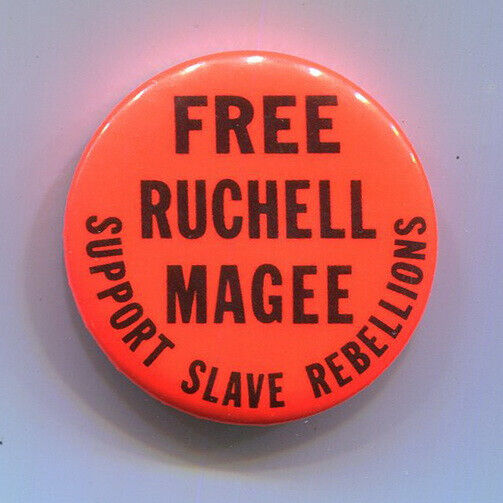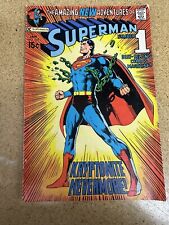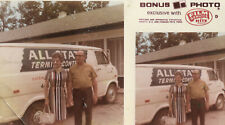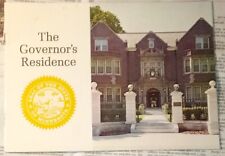|

On eBay Now...
c. 1971 Ruchell Magee Black Panthers Angelia Davis Soledad Brothers Cause Pin For Sale

When you click on links to various merchants on this site and make a purchase, this can result in this site earning a commission. Affiliate programs and affiliations include, but are not limited to, the eBay Partner Network.

c. 1971 Ruchell Magee Black Panthers Angelia Davis Soledad Brothers Cause Pin:
$149.95
OFFERED FOR SALE IS THIS 1 1/2 INCH CELLULOID PINBACK BUTTON IN WHAT I BELIEVE TO BE GREAT SHAPE. HOWEVER, THAT IS JUST MY OPINION. SEE PHOTOS OF FRONT AND BACK FOR CONDITION, AND YOU BE THE JUDGE. IF YOU HAVE ANY QUESTIONS, PLEASE CONTACT ME BEFORE offerDING OR BUYING. GUARANTEED AUTHENTIC AND ORIGINAL. I COMBINE SHIPPING CHARGES ON MULTIPLE ITEMS. PLEASE WAIT FOR OR REQUEST AND INVOICE WITH COMBINED SHIPPING CHARGES BEFORE PAYING FOR THE ITEMS This scarce pin was issued and sold circa 1970 - 1972 to raise funds and support for the legal defense and release of Black Panter Ruchell Cinque Magee, who, with others, participated in the 1970 courtroom escape attempt and kidnapping of Judge Haley. The attempt was facilitated by three guns registered to Angela Davis. The group sought a trade -- the release of Judge Haleyfor the three Soledad Brothers (which included George Jackson). During an effort to flee the courthouse in a van, a shoot-out withpolice took place, killing the younger brother of Jackson, two Black Panther prisoners and Judge Haley.
Ruchell Magee was the only abductor to survive. Before the 1970 shoot-out, and in an effort to overturn his prior conviction, Magee too the position that:“My fight is to expose the entire system, judicial and prison system, asystem of slavery,” he wrote. “This will cause benefit not just to myself butto all those who at this time are being criminally oppressed or enslaved bythis system.” The pin, with a day glow orange - red background (which glows under black light) reads: FREE RUCHELL MAGEE SUPPORT SLAVE REBELLIONS
In 1963, Ruchell Magee was convicted of aggravated kidnapping over a disputeinvolving $10 of marijuana. While in prison, Magee learned about AfricanAmerican history, the black liberation struggle and became politicized, joiningthe Black Panther Party. While imprisoned, Magee dedicated much of his time tostudying law and petitioning the court to challenge his conviction. In essence,Magee argued that his conviction was based on fraudulent grounds, denying himhis constitutional rights and holding him involuntarily, making him a slave. Assuch, he claimed, he and others had a legal right to do everything in theirpower to escape enslavement. During this period, Magee took the middle name “Cinque,” in honor of aslave who escaped the slave ship, Amistad. On August 7, 1970, a few months before Magee was eligible forparole, 17-year old Jonathan Jackson, the younger brother of black radical,George Jackson, burst into the Marin County courtroom of Judge Haley, where James McClain was on trial for assaulting a guard in thewake of a Black prisoner\'s murder by prison officials in SanQuentin Prison in February of 1970. Carrying three guns registered to Angela Davis, Jonathan Jackson, with the helpof McClain and Ruchell Cinque Magee, who was set to testify as a witness inMcClain\'s trial, seized Judge Haley and ordered attorneys, jurors and courtofficials to lie on the floor. Magee freed another testifying witness, BlackPanther William A. Christmas, who also aided in the escape attempt. In additionto their own freedom, the group sought a trade -- the release of Judge Haleyfor the “Soledad Brothers,” George Jackson, Fleeta Drumgo, and John Clutchette,who were charged with killing a white prison guard at California’s SoledadPrison. During an effort to flee the courthouse in a van, a shoot-out withpolice took place, killing Jonathan Jackson, McClain, Christmas and Judge Haley. Ruchell Magee was the only abductor to survive. In the legal proceeding that followed the incident, prosecutorsattempted to get Magee to testify against Angela Davis, but he refused.Ultimately, he pled guilty to aggravated kidnapping in exchange for theAttorney General requesting a charge of murder be dropped. This underground protest pinback button pin or badgerelates to the Hippie (Hippy) Counterculture Movement of the psychedelicSixties (1960s and Seventies (1970s).That movement included such themes and topics as peace, civil rights,radical, socialist, communist, anarchist, union labor strikes, drugs,marijuana, pot, weed, lsd, acid, sds, iww, anti draft, anti war, anti rotc,welfare rights, poverty, equal rights, integration, gay, women\'s rights, blackpanthers, black power, left wing, liberal, etc.progressive political movement and is guaranteed to be genuine asdescribed. THIS IS MY HOBBY AND IS NOT A BUSINESS. THIS AND MY OTHER ITEMS ON ARE FROM MY PERSONAL COLLECTIONS AND WERE NOT INITIALLY ACQUIRED BY ME FOR RESALE. PROCEEDS GO TO BUY OTHER STUFF I AM INTERESTED IN COLLECTING.
I AM A LONG TIME MEMBER OF A. P. I .C. (AMERICAN POLITICAL ITEMS COLLECTORS). IF YOU ARE NOT A MEMBER, YOU SHOULD CONSIDER JOINING. IT IS AGREAT ORGANIZATION! SHIPPING COST TO DESTINATIONS WITHIN THE UNITED IS $4.95
OUTSIDE THE UNITED STATES, SHIPPING IS THROUGH \'S GLOBAL SHIPPING PROGRAM. SETS THE TERMS AND CHARGES, OVER WHICH I HAVE NO CONTROL.
THANK YOU FOR YOUR INTEREST FOR SALE IS THIS 1 3/4 INCH CELLULOID PINBACK BUTTON IN WHAT I BELIEVE TO BE REALLY GREAT CONDITION. HOWEVER, THAT IS JUST MY OPINION. SEE PHOTOS OF FRONT AND BACK FOR CONDITION, AND YOU BE THE JUDGE. IF YOU HAVE ANY QUESTIONS, PLEASE CONTACT ME BEFORE offerDING OR BUYING. GUARANTEED AUTHENTIC AND ORIGINAL. This pin was issued and sold in 1968 in support of Eldridge Cleaver\'s presidential campaign on the Peace and Freedom Party ticket in California and other states. (In some states, other candidates were run, including Dick Gregory). Cleaver was best know as the Minister of Information of the Black Panther Party for Self Defense. The pin is a photo of Cleaver.
TheBlack Panther Party collaborated withthe Peace and Freedom Party,which sought to promote a strong anti Vietnam War and anti racist politics in oppositionto the establishment democratic party. The Black Panther Party provided neededlegitimacy to the Peace and Freedom Party\'s racial politics and in returnreceived invaluable support for the \"FreeHuey\" campaign. BLACKPANTHER PARTY The BlackPanther Party or BPP (originally the Black Panther Party for Self-Defense) wasa Black revolutionary socialist organization active in the United States from1966 until 1982, with its only international chapter operating in Algeria from1969 until 1972.
At itsinception on October 15, 1966, the Black Panther Party\'s core practice was itsarmed citizens\' patrols to monitor the behavior of police officers andchallenge police brutality in Oakland, California. In 1969, community socialprograms became a core activity of party members. The Black Panther Partyinstituted a variety of community social programs, most extensively the FreeBreakfast for Children Programs, and community health clinics.
FederalBureau of Investigation Director J. Edgar Hoover called the party \"thegreatest threat to the internal security of the country\", and hesupervised an extensive program (COINTELPRO)of surveillance, infiltration, perjury, police and FBI harassment, beatings andmurder, assassination of Panther members and leaders, and many other despicable,illegal and unconstitutional tactics designed to undermine Panther leadership, falselyincriminate party members, discredit and criminalize the Party, and drain theorganization of resources and manpower. The program was also usingassassination against Black Panther members. In his book Seize the Time, Bobby Seale, Chairman and Co-Founder of the Black Panther Party states that: \"In ourview it is a class struggle between the massive proletarian working class andthe small, minority ruling class. Working-class people of all colors must uniteagainst the exploitative, oppressive ruling class. So let me emphasize again—webelieve our fight is a class struggleand not a race struggle.\"
Black Panther Party membership reached a peak in1970, with offices in 68 cities and thousands of members. Some scholars of U.S.history, have characterized the Black Panther Party as the most influential blackmovement organization of the late 1960s, and \"the strongest link betweenthe domestic Black Liberation Struggle and global opponents of Americanimperialism\".
On July 10, 1964, a group of African American men in Jonesboro, Louisiana led by Earnest “Chilly Willy” Thomas and Frederick Douglas Kirkpatrick founded the group known as The Deacons for Defense and Justice to protect members of the Congress of Racial Equality (CORE) against Ku Klux Klan violence. Most of the “Deacons” were veterans of World War II and the Korean War. The Jonesboro chapter organized its first affiliate chapter in nearby Bogalusa, Louisiana led by Charles Sims, A.Z. Young and Robert Hicks. Eventually they organized a third chapter in Louisiana. The Deacons tense confrontation with the Klan in Bogalusa was crucial in forcing the federal government to intervene on behalf of the local African American community. The national attention they garnered also persuaded state and national officials to initiate efforts to neutralize the Klan in that area of the Deep South. The Deacons emerged as one of the first visible self-defense forces in the South and as such represented a new face of the civil rights movement. Traditional civil rights organizations remained silent on them or repudiated their activities. They were effective however in providing protection for local African Americans who sought to register to vote and for white and black civil rights workers in the area. The Deacons, for example, provided security for the 1966 March Against Fear from Memphis to Jackson, Mississippi. Moreover their presence in Southeastern Louisiana meant that the Klan would no longer be able to intimidate and terrorize local African Americans without challenge. The strategy and methods that the Deacons employed attracted the attention and concern of the Federal Bureau of Investigation (FBI), which authorized an investigation into the group’s activities. The investigation stalled, however, when more influential black power organizations such as US and the Black Panther Party emerged after the 1965 Watts Riot. With public attention, and the attention of the FBI focused elsewhere, the Deacons lost most of their notoriety and slowly declined in influence. By 1968 they were all but extinct. In 2003 the activities of the Deacons was the subject of a 2003, “Deacons for Defense.” - See more at: July 10, 1964, a group of African American men in Jonesboro, Louisiana led by Earnest “Chilly Willy” Thomas and Frederick Douglas Kirkpatrick founded the group known as The Deacons for Defense and Justice to protect members of the Congress of Racial Equality (CORE) against Ku Klux Klan violence. Most of the “Deacons” were veterans of World War II and the Korean War. The Jonesboro chapter organized its first affiliate chapter in nearby Bogalusa, Louisiana led by Charles Sims, A.Z. Young and Robert Hicks. Eventually they organized a third chapter in Louisiana. The Deacons tense confrontation with the Klan in Bogalusa was crucial in forcing the federal government to intervene on behalf of the local African American community. The national attention they garnered also persuaded state and national officials to initiate efforts to neutralize the Klan in that area of the Deep South. The Deacons emerged as one of the first visible self-defense forces in the South and as such represented a new face of the civil rights movement. Traditional civil rights organizations remained silent on them or repudiated their activities. They were effective however in providing protection for local African Americans who sought to register to vote and for white and black civil rights workers in the area. The Deacons, for example, provided security for the 1966 March Against Fear from Memphis to Jackson, Mississippi. Moreover their presence in Southeastern Louisiana meant that the Klan would no longer be able to intimidate and terrorize local African Americans without challenge. The strategy and methods that the Deacons employed attracted the attention and concern of the Federal Bureau of Investigation (FBI), which authorized an investigation into the group’s activities. The investigation stalled, however, when more influential black power organizations such as US and the Black Panther Party emerged after the 1965 Watts Riot. With public attention, and the attention of the FBI focused elsewhere, the Deacons lost most of their notoriety and slowly declined in influence. By 1968 they were all but extinct. In 2003 the activities of the Deacons was the subject of a 2003, “Deacons for Defense.” - See more at: July 10, 1964, a group of African American men in Jonesboro, Louisiana led by Earnest “Chilly Willy” Thomas and Frederick Douglas Kirkpatrick founded the group known as The Deacons for Defense and Justice to protect members of the Congress of Racial Equality (CORE) against Ku Klux Klan violence. Most of the “Deacons” were veterans of World War II and the Korean War. The Jonesboro chapter organized its first affiliate chapter in nearby Bogalusa, Louisiana led by Charles Sims, A.Z. Young and Robert Hicks. Eventually they organized a third chapter in Louisiana. The Deacons tense confrontation with the Klan in Bogalusa was crucial in forcing the federal government to intervene on behalf of the local African American community. The national attention they garnered also persuaded state and national officials to initiate efforts to neutralize the Klan in that area of the Deep South. The Deacons emerged as one of the first visible self-defense forces in the South and as such represented a new face of the civil rights movement. Traditional civil rights organizations remained silent on them or repudiated their activities. They were effective however in providing protection for local African Americans who sought to register to vote and for white and black civil rights workers in the area. The Deacons, for example, provided security for the 1966 March Against Fear from Memphis to Jackson, Mississippi. Moreover their presence in Southeastern Louisiana meant that the Klan would no longer be able to intimidate and terrorize local African Americans without challenge. The strategy and methods that the Deacons employed attracted the attention and concern of the Federal Bureau of Investigation (FBI), which authorized an investigation into the group’s activities. The investigation stalled, however, when more influential black power organizations such as US and the Black Panther Party emerged after the 1965 Watts Riot. With public attention, and the attention of the FBI focused elsewhere, the Deacons lost most of their notoriety and slowly declined in influence. By 1968 they were all but extinct. In 2003 the activities of the Deacons was the subject of a 2003, “Deacons for Defense.” - See more at: July 10, 1964, a group of African American men in Jonesboro, Louisiana led by Earnest “Chilly Willy” Thomas and Frederick Douglas Kirkpatrick founded the group known as The Deacons for Defense and Justice to protect members of the Congress of Racial Equality (CORE) against Ku Klux Klan violence. Most of the “Deacons” were veterans of World War II and the Korean War. The Jonesboro chapter organized its first affiliate chapter in nearby Bogalusa, Louisiana led by Charles Sims, A.Z. Young and Robert Hicks. Eventually they organized a third chapter in Louisiana. The Deacons tense confrontation with the Klan in Bogalusa was crucial in forcing the federal government to intervene on behalf of the local African American community. The national attention they garnered also persuaded state and national officials to initiate efforts to neutralize the Klan in that area of the Deep South. The Deacons emerged as one of the first visible self-defense forces in the South and as such represented a new face of the civil rights movement. Traditional civil rights organizations remained silent on them or repudiated their activities. They were effective however in providing protection for local African Americans who sought to register to vote and for white and black civil rights workers in the area. The Deacons, for example, provided security for the 1966 March Against Fear from Memphis to Jackson, Mississippi. Moreover their presence in Southeastern Louisiana meant that the Klan would no longer be able to intimidate and terrorize local African Americans without challenge. The strategy and methods that the Deacons employed attracted the attention and concern of the Federal Bureau of Investigation (FBI), which authorized an investigation into the group’s activities. The investigation stalled, however, when more influential black power organizations such as US and the Black Panther Party emerged after the 1965 Watts Riot. With public attention, and the attention of the FBI focused elsewhere, the Deacons lost most of their notoriety and slowly declined in influence. By 1968 they were all but extinct. In 2003 the activities of the Deacons was the subject of a 2003, “Deacons for Defense.” - See more at: July 10, 1964, a group of African American men in Jonesboro, Louisiana led by Earnest “Chilly Willy” Thomas and Frederick Douglas Kirkpatrick founded the group known as The Deacons for Defense and Justice to protect members of the Congress of Racial Equality (CORE) against Ku Klux Klan violence. Most of the “Deacons” were veterans of World War II and the Korean War. The Jonesboro chapter organized its first affiliate chapter in nearby Bogalusa, Louisiana led by Charles Sims, A.Z. Young and Robert Hicks. Eventually they organized a third chapter in Louisiana. The Deacons tense confrontation with the Klan in Bogalusa was crucial in forcing the federal government to intervene on behalf of the local African American community. The national attention they garnered also persuaded state and national officials to initiate efforts to neutralize the Klan in that area of the Deep South. - See more at: underground pinback button pin or badge relates to the Hippie (or Hippy) Counterculture Movement of the psychedelic Sixties (1960\'s) and Seventies (1970\'s). That movement included such themes and topics as peace, protest, civil rights, radical, socialist, communist, anarchist, union labor strikes, drugs, marijuana, pot, weed, lsd, acid, sds, iww, anti draft, anti war, anti rotc, welfare rights, poverty, equal rights, integration, gay, women\'s rights, black panthers, black power, left wing, liberal, etc. progressive political movement and is guaranteed to be genuine as described.
The Deacons emerged as one of the first visible self-defense forces in the South and as such represented a new face of the civil rights movement. Traditional civil rights organizations remained silent on them or repudiated their activities. They were effective however in providing protection for local African Americans who sought to register to vote and for white and black civil rights workers in the area. The Deacons, for example, provided security for the 1966 March Against Fear from Memphis to Jackson, Mississippi. Moreover their presence in Southeastern Louisiana meant that the Klan would no longer be able to intimidate and terrorize local African Americans without challenge. The strategy and methods that the Deacons employed attracted the attention and concern of the Federal Bureau of Investigation (FBI), which authorized an investigation into the group’s activities. The investigation stalled, however, when more influential black power organizations such as US and the Black Panther Party emerged after the 1965 Watts Riot. With public attention, and the attention of the FBI focused elsewhere, the Deacons lost most of their notoriety and slowly declined in influence. By 1968 they were all but extinct. In 2003 the activities of the Deacons was the subject of a 2003, “Deacons for Defense.” - See more at: July 10, 1964, a group of African American men in Jonesboro, Louisiana led by Earnest “Chilly Willy” Thomas and Frederick Douglas Kirkpatrick founded the group known as The Deacons for Defense and Justice to protect members of the Congress of Racial Equality (CORE) against Ku Klux Klan violence. Most of the “Deacons” were veterans of World War II and the Korean War. The Jonesboro chapter organized its first affiliate chapter in nearby Bogalusa, Louisiana led by Charles Sims, A.Z. Young and Robert Hicks. Eventually they organized a third chapter in Louisiana. The Deacons tense confrontation with the Klan in Bogalusa was crucial in forcing the federal government to intervene on behalf of the local African American community. The national attention they garnered also persuaded state and national officials to initiate efforts to neutralize the Klan in that area of the Deep South. The Deacons emerged as one of the first visible self-defense forces in the South and as such represented a new face of the civil rights movement. Traditional civil rights organizations remained silent on them or repudiated their activities. They were effective however in providing protection for local African Americans who sought to register to vote and for white and black civil rights workers in the area. The Deacons, for example, provided security for the 1966 March Against Fear from Memphis to Jackson, Mississippi. Moreover their presence in Southeastern Louisiana meant that the Klan would no longer be able to intimidate and terrorize local African Americans without challenge. The strategy and methods that the Deacons employed attracted the attention and concern of the Federal Bureau of Investigation (FBI), which authorized an investigation into the group’s activities. The investigation stalled, however, when more influential black power organizations such as US and the Black Panther Party emerged after the 1965 Watts Riot. With public attention, and the attention of the FBI focused elsewhere, the Deacons lost most of their notoriety and slowly declined in influence. By 1968 they were all but extinct. In 2003 the activities of the Deacons was the subject of a 2003, “Deacons for Defense.” - See more at: July 10, 1964, a group of African American men in Jonesboro, Louisiana led by Earnest “Chilly Willy” Thomas and Frederick Douglas Kirkpatrick founded the group known as The Deacons for Defense and Justice to protect members of the Congress of Racial Equality (CORE) against Ku Klux Klan violence. Most of the “Deacons” were veterans of World War II and the Korean War. The Jonesboro chapter organized its first affiliate chapter in nearby Bogalusa, Louisiana led by Charles Sims, A.Z. Young and Robert Hicks. Eventually they organized a third chapter in Louisiana. The Deacons tense confrontation with the Klan in Bogalusa was crucial in forcing the federal government to intervene on behalf of the local African American community. The national attention they garnered also persuaded state and national officials to initiate efforts to neutralize the Klan in that area of the Deep South. The Deacons emerged as one of the first visible self-defense forces in the South and as such represented a new face of the civil rights movement. Traditional civil rights organizations remained silent on them or repudiated their activities. They were effective however in providing protection for local African Americans who sought to register to vote and for white and black civil rights workers in the area. The Deacons, for example, provided security for the 1966 March Against Fear from Memphis to Jackson, Mississippi. Moreover their presence in Southeastern Louisiana meant that the Klan would no longer be able to intimidate and terrorize local African Americans without challenge. The strategy and methods that the Deacons employed attracted the attention and concern of the Federal Bureau of Investigation (FBI), which authorized an investigation into the group’s activities. The investigation stalled, however, when more influential black power organizations such as US and the Black Panther Party emerged after the 1965 Watts Riot. With public attention, and the attention of the FBI focused elsewhere, the Deacons lost most of their notoriety and slowly declined in influence. By 1968 they were all but extinct. In 2003 the activities of the Deacons was the subject of a 2003, “Deacons for Defense.” - See more at: July 10, 1964, a group of African American men in Jonesboro, Louisiana led by Earnest “Chilly Willy” Thomas and Frederick Douglas Kirkpatrick founded the group known as The Deacons for Defense and Justice to protect members of the Congress of Racial Equality (CORE) against Ku Klux Klan violence. Most of the “Deacons” were veterans of World War II and the Korean War. The Jonesboro chapter organized its first affiliate chapter in nearby Bogalusa, Louisiana led by Charles Sims, A.Z. Young and Robert Hicks. Eventually they organized a third chapter in Louisiana. The Deacons tense confrontation with the Klan in Bogalusa was crucial in forcing the federal government to intervene on behalf of the local African American community. The national attention they garnered also persuaded state and national officials to initiate efforts to neutralize the Klan in that area of the Deep South. - See more at: IS MY HOBBY AND IS NOT A BUSINESS. THIS AND MY OTHER ITEMS ON ARE FROM MY PERSONAL COLLECTIONS AND WERE NOT INITIALLY ACQUIRED BY ME FOR RESALE. PROCEEDS GO TO BUY OTHER STUFF I AM INTERESTED IN COLLECTING.
I HAVE BEEN A LONG TIME MEMBER OF A. P. I .C. (AMERICAN POLITICAL ITEMS COLLECTORS). IF YOU ARE NOT A MEMBER, YOU SHOULD CONSIDER JOINING. IT IS AGREAT ORGANIZATION! SHIPPING: ITEMS WILL BE SAFELY PACKED TO AVOID DAMAGE DURING SHIPPING. ITEMS ARE SHIPPED BY FIRST CLASS MAIL.
SHIPPING COST TO DESTINATIONS WITHIN THE UNITED STATES IS $4.00.
OUTSIDE THE UNITED STATES, THE SHIPPING COST IS $15.00.
I AM GLAD TO REDUCE SHIPPING CHARGES ON MULTIPLE ITEMS.HOWEVER IF YOU WOULD LIKE A COMBINED SHIPPING CHARGE, YOU MUST WAIT TO RECEIVE AN INVOICE WITH THE REDUCED CHARGE BEFORE PAYING, OR REQUEST AN INVOICE WITH COMBINED SHIPPING BEFORE PAYING, AND PAY UPON RECEIPT. OTHERWISE, I CANNOT REFUND SHIPPING COSTS ONCE PAID.
THANK YOU FOR YOUR INTEREST.
The Deacons emerged as one of the first visible self-defense forces in the South and as such represented a new face of the civil rightsmovement. Traditional civil rights organizations remained silent onthem or repudiated their activities. They were effective however inproviding protection for local African Americans who sought to registerto vote and for white and black civil rights workers in the area. TheDeacons, for example, provided security for the 1966 March Against Fearfrom Memphis to Jackson, Mississippi.Moreover their presence in Southeastern Louisiana meant that the Klanwould no longer be able to intimidate and terrorize local AfricanAmericans without challenge. The strategy and methods that the Deacons employed attracted theattention and concern of the Federal Bureau of Investigation (FBI),which authorized an investigation into the group’s activities. Theinvestigation stalled, however, when more influential black powerorganizations such as US and the Black Panther Party emerged after the 1965 Watts Riot.With public attention, and the attention of the FBI focused elsewhere,the Deacons lost most of their notoriety and slowly declined ininfluence. By 1968 they were all but extinct. In 2003 the activitiesof the Deacons was the subject of a 2003, “Deacons for Defense.”- See more July 10, 1964, a group of African American men in Jonesboro, Louisianaled by Earnest “Chilly Willy” Thomas and Frederick Douglas Kirkpatrickfounded the group known as The Deacons for Defense and Justice toprotect members of the Congress of Racial Equality (CORE) against Ku Klux Klan violence. Most of the “Deacons” were veterans of World War II and the Korean War.The Jonesboro chapter organized its first affiliate chapter in nearbyBogalusa, Louisiana led by Charles Sims, A.Z. Young and Robert Hicks.Eventually they organized a third chapter in Louisiana. The Deaconstense confrontation with the Klan in Bogalusa was crucial in forcing thefederal government to intervene on behalf of the local African Americancommunity. The national attention they garnered also persuaded stateand national officials to initiate efforts to neutralize the Klan inthat area of the Deep South. The Deacons emerged as one of the first visible self-defense forces in the South and as such represented a new face of the civil rightsmovement. Traditional civil rights organizations remained silent onthem or repudiated their activities. They were effective however inproviding protection for local African Americans who sought to registerto vote and for white and black civil rights workers in the area. TheDeacons, for example, provided security for the 1966 March Against Fearfrom Memphis to Jackson, Mississippi.Moreover their presence in Southeastern Louisiana meant that the Klanwould no longer be able to intimidate and terrorize local AfricanAmericans without challenge. The strategy and methods that the Deacons employed attracted theattention and concern of the Federal Bureau of Investigation (FBI),which authorized an investigation into the group’s activities. Theinvestigation stalled, however, when more influential black powerorganizations such as US and the Black Panther Party emerged after the 1965 Watts Riot.With public attention, and the attention of the FBI focused elsewhere,the Deacons lost most of their notoriety and slowly declined ininfluence. By 1968 they were all but extinct. In 2003 the activitiesof the Deacons was the subject of a 2003, “Deacons for Defense.”- See more July 10, 1964, a group of African American men in Jonesboro, Louisianaled by Earnest “Chilly Willy” Thomas and Frederick Douglas Kirkpatrickfounded the group known as The Deacons for Defense and Justice toprotect members of the Congress of Racial Equality (CORE) against Ku Klux Klan violence. Most of the “Deacons” were veterans of World War II and the Korean War.The Jonesboro chapter organized its first affiliate chapter in nearbyBogalusa, Louisiana led by Charles Sims, A.Z. Young and Robert Hicks.Eventually they organized a third chapter in Louisiana. The Deaconstense confrontation with the Klan in Bogalusa was crucial in forcing thefederal government to intervene on behalf of the local African Americancommunity. The national attention they garnered also persuaded stateand national officials to initiate efforts to neutralize the Klan inthat area of the Deep South. The Deacons emerged as one of the first visible self-defense forces in the South and as such represented a new face of the civil rightsmovement. Traditional civil rights organizations remained silent onthem or repudiated their activities. They were effective however inproviding protection for local African Americans who sought to registerto vote and for white and black civil rights workers in the area. TheDeacons, for example, provided security for the 1966 March Against Fearfrom Memphis to Jackson, Mississippi.Moreover their presence in Southeastern Louisiana meant that the Klanwould no longer be able to intimidate and terrorize local AfricanAmericans without challenge. The strategy and methods that the Deacons employed attracted theattention and concern of the Federal Bureau of Investigation (FBI),which authorized an investigation into the group’s activities. Theinvestigation stalled, however, when more influential black powerorganizations such as US and the Black Panther Party emerged after the 1965 Watts Riot.With public attention, and the attention of the FBI focused elsewhere,the Deacons lost most of their notoriety and slowly declined ininfluence. By 1968 they were all but extinct. In 2003 the activitiesof the Deacons was the subject of a 2003, “Deacons for Defense.”- See more July 10, 1964, a group of African American men in Jonesboro, Louisianaled by Earnest “Chilly Willy” Thomas and Frederick Douglas Kirkpatrickfounded the group known as The Deacons for Defense and Justice toprotect members of the Congress of Racial Equality (CORE) against Ku Klux Klan violence. Most of the “Deacons” were veterans of World War II and the Korean War.The Jonesboro chapter organized its first affiliate chapter in nearbyBogalusa, Louisiana led by Charles Sims, A.Z. Young and Robert Hicks.Eventually they organized a third chapter in Louisiana. The Deaconstense confrontation with the Klan in Bogalusa was crucial in forcing thefederal government to intervene on behalf of the local African Americancommunity. The national attention they garnered also persuaded stateand national officials to initiate efforts to neutralize the Klan inthat area of the Deep South. - See more


The Betty Crocker Recipe Card Library c1971, Mostly Complete $29.99

Superman #233 Neal Adams Classic Iconic Cover D.C. 1971 $160.00

c.1971 Original Vintage Drink Grapette Soda Sign Metal Embossed Fruit Juicy Gas $779.00

c1971 First Baptist Church Saginaw Glenn Fresno California CA Vintage Postcard $29.95

C.1971 ALL-STATE TERMITE CONTROL VAN MAN & WOMAN HITE PHOTO N1 $19.99

Kaywoodie Collector’s 11C 1971-72 Estate Tobacco Pipe $175.00

The Governor's Residence - Minnesota - c. 1971 $23.99

c1971 USAF F111 jet plane pilot 35mm aircraft slide kodachrome military $53.99
|